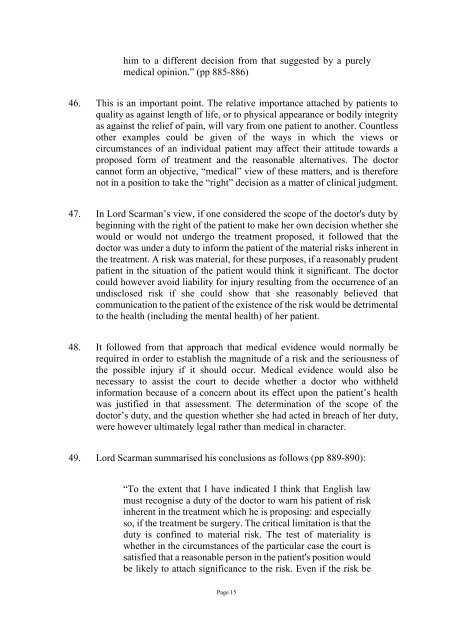Montgomery (Appellant) v Lanarkshire Health Board (Respondent) (Scotland)
1DEA9DQ
1DEA9DQ
You also want an ePaper? Increase the reach of your titles
YUMPU automatically turns print PDFs into web optimized ePapers that Google loves.
him to a different decision from that suggested by a purely<br />
medical opinion.” (pp 885-886)<br />
46. This is an important point. The relative importance attached by patients to<br />
quality as against length of life, or to physical appearance or bodily integrity<br />
as against the relief of pain, will vary from one patient to another. Countless<br />
other examples could be given of the ways in which the views or<br />
circumstances of an individual patient may affect their attitude towards a<br />
proposed form of treatment and the reasonable alternatives. The doctor<br />
cannot form an objective, “medical” view of these matters, and is therefore<br />
not in a position to take the “right” decision as a matter of clinical judgment.<br />
47. In Lord Scarman’s view, if one considered the scope of the doctor's duty by<br />
beginning with the right of the patient to make her own decision whether she<br />
would or would not undergo the treatment proposed, it followed that the<br />
doctor was under a duty to inform the patient of the material risks inherent in<br />
the treatment. A risk was material, for these purposes, if a reasonably prudent<br />
patient in the situation of the patient would think it significant. The doctor<br />
could however avoid liability for injury resulting from the occurrence of an<br />
undisclosed risk if she could show that she reasonably believed that<br />
communication to the patient of the existence of the risk would be detrimental<br />
to the health (including the mental health) of her patient.<br />
48. It followed from that approach that medical evidence would normally be<br />
required in order to establish the magnitude of a risk and the seriousness of<br />
the possible injury if it should occur. Medical evidence would also be<br />
necessary to assist the court to decide whether a doctor who withheld<br />
information because of a concern about its effect upon the patient’s health<br />
was justified in that assessment. The determination of the scope of the<br />
doctor’s duty, and the question whether she had acted in breach of her duty,<br />
were however ultimately legal rather than medical in character.<br />
49. Lord Scarman summarised his conclusions as follows (pp 889-890):<br />
“To the extent that I have indicated I think that English law<br />
must recognise a duty of the doctor to warn his patient of risk<br />
inherent in the treatment which he is proposing: and especially<br />
so, if the treatment be surgery. The critical limitation is that the<br />
duty is confined to material risk. The test of materiality is<br />
whether in the circumstances of the particular case the court is<br />
satisfied that a reasonable person in the patient's position would<br />
be likely to attach significance to the risk. Even if the risk be<br />
Page 15


